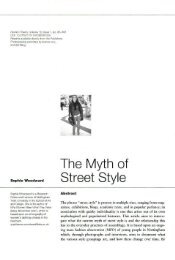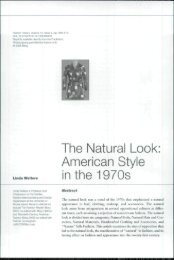Spinning the Ephemeral PDF - SMU Fashion Media
Spinning the Ephemeral PDF - SMU Fashion Media
Spinning the Ephemeral PDF - SMU Fashion Media
Create successful ePaper yourself
Turn your PDF publications into a flip-book with our unique Google optimized e-Paper software.
284 Fiona Anderson<br />
<strong>the</strong>re has been scant academic research about tweed cloth since 1973,<br />
when Clifford Gulvin pubhshed his detailed study The Tweedmakers: A<br />
History of <strong>the</strong> Scottish Fancy Woollen Industry 1600-/9/4.' This comprehensive<br />
work follows a typical methodology of an economic historian<br />
of <strong>the</strong> period, in that few if any connections are made between <strong>the</strong> production<br />
of <strong>the</strong> cloth and <strong>the</strong> consumers who wore <strong>the</strong> cloth made up into<br />
garments.<br />
This article explores <strong>the</strong> topic of tweed cloth as a menswear textile in<br />
<strong>the</strong> late nineteenth century with rhe aitn of expanding <strong>the</strong> consideration<br />
of <strong>the</strong> relationships between fashion in tnodernity and rural and urban<br />
landscapes. The article does not contest <strong>the</strong> idea that modern fashion is<br />
predominantly an urban phenomenon. However, by analyzing a fashion<br />
textile produced within a rural context it aims to complexify <strong>the</strong> assumption<br />
that late nineteenth century fashion may be understood simply in <strong>the</strong><br />
one-dimensional sense of being related to <strong>the</strong> urban. Examining <strong>the</strong><br />
history of tweed as an ephemeral fashion textile within <strong>the</strong> context of<br />
recent literature from cultural geography, empire studies, and gender<br />
studies presents interesting new perspectives about <strong>the</strong> relationships<br />
between fashion in modernity and urban and rural landscapes. The article<br />
argues <strong>the</strong> design of tweed constituted a blending, or intermingling of <strong>the</strong><br />
dynamics of fashion and urban sartorial tastes and lifestyles, with rural<br />
environments and contexts. It thus eloquently epitomizes <strong>the</strong> dual role<br />
of fashion within modernity as encapsulating <strong>the</strong> transitory and <strong>the</strong><br />
sublime (Lchmann 2000).<br />
Origins and Deveiopment of <strong>the</strong> IWeed Industry<br />
Tweed cloth of <strong>the</strong> late nineteenth century had highly specific origins, that<br />
gave it a particular named identity, that of Scotch tweed. Gulvin pinpoints<br />
<strong>the</strong> period from 1829 onwards, as <strong>the</strong> era in which tweed was transformed<br />
from hodden gray cloth, a local craft product made in <strong>the</strong> Borders of<br />
Scotland, into a fashion textile woven in a factory. At that time <strong>the</strong> Scottish<br />
woolen industry saw a drastic decline in <strong>the</strong> market for <strong>the</strong> coarse drab<br />
blue woolen cloth that it was known for and also saw <strong>the</strong> fancy patterns<br />
that were later known as tweed sold in London for <strong>the</strong> first time. This<br />
shift was partly precipitated by <strong>the</strong> adoption of ano<strong>the</strong>r lowly cloth; <strong>the</strong><br />
black-and-white checked plaid used by shepherds in <strong>the</strong> Scottish Borders<br />
to protect <strong>the</strong>mselves and young lambs from inclement wea<strong>the</strong>r {Figure<br />
1). The shepherd check as it became known was adopted as a fashionable<br />
cloth for menswear in <strong>the</strong> late 1820s (Figure 2). Its popularity was to a<br />
certain extent fueled by Sir Walter Scott; however, its adoption as a men's<br />
trousering cloth may also be linked to Lord Brougham. The fashionability<br />
of this cloth was also encouraged by Archibald Craig, a cloth merchant<br />
from Edinburgh, and James Locke, a London-based tailor. The latter was<br />
initially based in Covent Garden, but around 1830 he moved to <strong>the</strong> more




